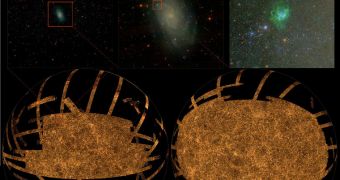The general public has been granted access to the most detailed color image of the sky ever to be produced. The image was presented on January 11 in Seattle, at the 217th winter meeting of the American Astronomical Society (AAS 2011).
According to the experts who compiled this monumental work, the image contains more than a trillion pixels, and is made up of several million 2.8-megapixel images captured by various space- and ground-based telescopes over the last decade.
All the raw data was then processed and stitched together into this view of the sky. The team that created it is also the one in charge of the Sloan Digital Sky Survey-III (SDSS-III).
The experts are very proud of what they have accomplished, and for good reason. They estimate that more than 500,000 high-definition TV sets would be required to display their photo at full resolution.
“This image provides opportunities for many new scientific discoveries in the years to come,” said in a statement University of Portsmouth expert Bob Nichol, who was a part of the team.
At the AAS 2011 meeting, experts with the SDSS-III collaboration released a flow of data, of which the new view of the night sky was the centerpiece. Together with previously-released views of the night sky, the new photo will provide experts with the most comprehensive view of the sky ever.
The SDSS Collaboration is one of the most prolific astronomical endeavors in history, having already discovered more than 500 million asteroids, stars, galaxies and distant quasars, among other objects.
Accompanying the release of the map were also the latest readings on the colors, shapes and positions of most of these objects, brought together in a comprehensive catalog, Space reports.
“This is one of the biggest bounties in the history of science. This data will be a legacy for the ages, as previous ambitious sky surveys like the Palomar Sky Survey of the 1950s are still being used today,” says astronomer Mike Blanton.
The expert, who is based at the New York University, is the leader of the data archive work in SDSS-III. The survey has been using the 138-megapixel camera on the 2.5-meter telescope at the Apache Point Observatory in New Mexico for its observations since 1998.
“It's been wonderful to see the science results that have come from this camera. It's a bittersweet feeling to see this camera retired, because I've been working with it for nearly 20 years,” says Connie Rockosi.
She started working with the camera in the 1990s, while still an undergraduate student at the University of Cali in Santa Cruz.
“The SDSS-III is an amazingly diverse project built on the legacy of the original SDSS and SDSS-II surveys. This image is the culmination of decades of work by hundreds of people and has already produced many incredible discoveries,” Nichol concludes.

 14 DAY TRIAL //
14 DAY TRIAL //